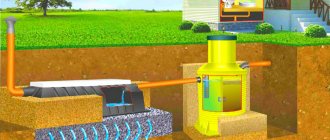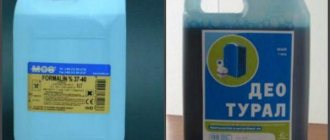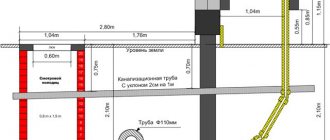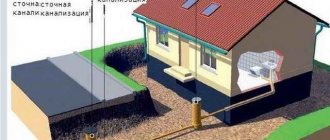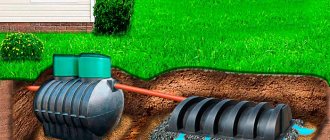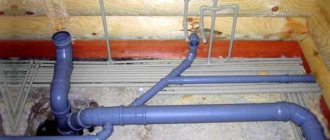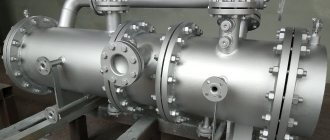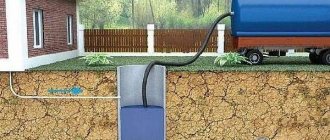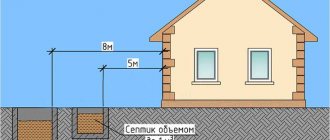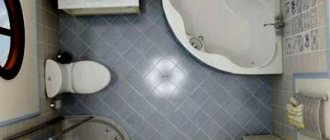Do I need to clean and how often?
Periodic pumping of wastewater sites is mandatory, especially simple structures - settling tanks and storage tanks. During the period of use of the sewerage system, waste accumulates at the bottom of the wells, a layer of silt and fatty deposits is formed that interfere with the drainage of wastewater. If you do not clean out sediment from buildings, you can get problems:
- Overflow of foul-smelling sewage.
- The smell of decaying waste.
- The emergence and reproduction of infectious viruses.
- Attracting insects and rodents to the area.
- Environmental damage and aesthetic unattractiveness.
The solution is systematic cleaning of the cesspool. The frequency of cleaning the chamber depends on the period of operation of the house, the number of drainage sources and residents. You can clean out latrines using traditional methods:
- for seasonal residence and a small volume of waste, the mine and containers are cleaned with your own hands;
- permanent residence in the house will require the use of sewage disposal equipment to pump out accumulated wastewater;
- the presence of a simple septic tank, using biological products, will reduce the number of treatment activities due to processing by bacteria and subsequent drainage of purified water into the ground;
- The chemical method of getting rid of sewage is associated with the effect of the drugs used on solid waste, transformation into liquid and further removal to the disposal site.
Certain difficulties in cleaning latrines and pumping out sewage arise when it is necessary to operate the structure in winter.
In 40-degree frosts, poorly insulated sewers can freeze. Therefore, maximum attention is paid to the issue of protection from cold when preparing the system for winter operation.
How to clean a cesspool without pumping
Nitrate oxidizers are environmentally friendly
If calling a sewer truck is not possible, you can choose other methods to clean the cesspool.
Chemical compositions
They decompose waste and remove disgusting odors. Use only approved compounds. Formaldehyde and quicklime are prohibited because they pose an environmental hazard and are harmful to the health of home residents.
The following compositions are suitable for cleaning the pit:
- Ammonium compounds. They are inexpensive, but draining clarified water into the soil is impossible. You will have to call specialists for disposal. If the waste liquid contains impurities of household chemicals, the efficiency decreases. Use in cesspools with metal elements is not recommended due to the risk of their destruction.
- Nitrate (nitrogen) oxidizing agents. Harmless, but expensive. The composition is similar to nitrogen fertilizers. Not susceptible to household chemicals in sewage drains. In addition to decomposing biological impurities, they remove unpleasant odors.
- Acidic cleaners. The principle of action is similar to nitrogen compounds. Suitable for dissolving sludge, suspended solids and neutralizing harmful bacteria. Use in buildings with plastic walls and in open cesspools is not permissible.
If the problem is not an overflowing pit, but clogged sewer lines, use caustic soda.
Chemical compositions are not afraid of frost and sudden temperature changes. They are produced in the form of tablets, liquids, granules and powder. Before use, the latter are dissolved in water and poured into the sewer. Tablets and liquids are immediately sent to the cesspool, which is convenient in country toilets.
Bioactive drugs
Biological products only work at above-zero temperatures
The processing of sewage waste occurs due to the vital activity of microorganisms: aerobic and anaerobic. They are able to decompose organic matter and turn sewage into a cloudy, odorless liquid. The amount of feces is reduced by half. Bacteria are also used to sanitize pits that have not yet been filled.
Aerobic purifiers require an influx of free oxygen to function; anaerobic purifiers do not need it. Thanks to this, they can be placed in sealed containers. The frequency of cleaning cesspools using sewage disposal equipment when using bioorganisms is significantly reduced.
Advantages of biological products:
- efficient processing of fats, solid organic waste, feces;
- safety for people, animals, plants;
- no impact on the materials from which the cesspool is created;
- the possibility of restoring drainage and improving the throughput of a cesspool with a filter at the bottom.
The disadvantage is that colonies of microorganisms must be constantly updated, and this is not cheap. In addition, bacteria die at sub-zero temperatures and contact with chemicals. Waste liquid with chemical impurities must not be poured into the cesspool.
Bioactive agents are produced in the form of tablets, granules, liquids and powders. Some can be immediately sent to the cesspool, others require preliminary dilution with water. This point is necessarily emphasized in the instructions for use.
The activity of bacteria is activated two hours after they are placed in the pit. Four hours later the stench disappears. Biological drugs work only at temperatures from 4 to 30 degrees Celsius.
Traditional methods
Sawdust absorbs liquid. You need to remove them manually
You can clean a cesspool using folk remedies; the material basis for them is present in every area. These include:
- sawdust (preferably from coniferous trees);
- peat;
- nettle;
- tomato tops;
- mint and basil leaves.
Sawdust and peat absorb the contents. The cesspool is dehydrated and the disgusting smell disappears. The downside is that such products do not dissolve and must be removed manually. But if you place the substance in a compost pit, after a season you will get an excellent fertilizer.
You can’t clean a hole with herbal remedies, but it is possible to remove the disgusting smell. Herbs contain substances that kill microorganisms, the activity of which causes stench.
Sewage pits are also cleaned mechanically using a pump or even scooping with a bucket. This unpleasant work is done every year: it is difficult to handle a large amount manually. Afterwards, the cesspool is washed with water from a hose to slow down the process of rocky growths appearing on the walls.
How to clean, methods
Each method of keeping wastewater treatment plants clean and operational has its pros and cons. Effective cleaning depends on the design of the specific cleaning facility and the financial capabilities of the owners of country houses or private houses. The main ways to get rid of impurities include:
- using sewage pumps to pump waste fluid out of the structure;
- manual cleaning of the mine with a bucket is used after removing the liquid fraction from the pit;
- a sewer truck pumps the mass into a tank using a vacuum pump;
- the use of biological products in a septic tank with a sealed bottom for the decomposition of solid waste and recycling into water;
- chemicals are used in sealed septic tanks to process waste into water with subsequent pumping into a sewer machine:
- the use of a sludge sucker for the solid layer of sludge and waste at the bottom of the mine.
Prevention of siltation
In order to solve the problem of how to remove sludge from a cesspool at a lower cost, it is useful to apply the following preventive measures:
- Do not flush solid waste, personal hygiene items, or toilet paper down the drain as they obstruct the passage of the cesspool.
- It is quite difficult to clean grease from the drain pit, so it is advisable to install a grease trap in the kitchen under the sink or in the dishwasher drain.
- If possible, it is better to separate waste gray water (discharge it into a drainage well) and fecal waste - chemical reagents significantly reduce the productivity of anaerobic bacteria and some drugs.
Operating principle of a grease trap
If the cesspool is clogged due to silting, then the methods for cleaning it depend on the financial resources of the user. The most expensive way is to call a special suction pump, which is designed to pump out this type of fraction. To reduce costs, they often use a sewer truck and then clean out the pit using hand tools or an electric fecal pump.
How to pump out with a suction pump
Rapid filling of the shaft with wastewater, the appearance of fatty deposits on the walls of the chamber, a persistent, unpleasant odor are characteristic signs of a silted drainage bottom of a well that prevents the absorption of moisture into the soil, or a large layer of solid residue in a sealed chamber.
To pump out the pit and remove sediment, a special suction unit mounted on a vehicle chassis is used. Equipment included:
- Vacuum pump driven by a car engine.
- A tank with two compartments: one for sludge and sludge, the second for process water. The back wall of the barrel opens to unload waste.
- Suction boom with hose for collecting sludge and solid sediment.
- A four-way valve that switches from vacuum to pressure for preliminary washout of compacted silt and soil.
For the sludge pump to operate, a reliable access must be prepared so that when pumping out sludge, the intake pipe reaches the bottom of the chamber. Technological operations are performed in the following sequence:
- from the cabin, through the remote control, air is supplied to the pneumatic system of the installation after opening the tap;
- sludge level control is activated;
- the vacuum pump is turned on and a vacuum is created in the tank;
- Using a remote control, the valve on the suction pipe lowered into the pit opens and sludge is drawn in. The filling of the tank is monitored through inspection windows;
- filling of the barrel stops after the sound signal from the sludge level control system;
- to liquefy the solid sludge residue at the bottom of the chamber, the four-way valve switches to the “Discharge” position, and process water from the tank under pressure washes away the sediment;
- after liquefying the remaining sludge, the suction operation is repeated, the well is cleaned;
Using a sludge pump is not a cheap cleaning option, but the quality of sludge pumping and the work of professionals will quickly bring the sewage system into working order for a long time.
Folk remedies
“Experienced” summer residents know many ways to clean a toilet without “chemicals.” Fortunately, it’s easy to find them in the country. These include:
- peat;
- sawdust;
- nettle;
- tomato tops.
All these products are quite easy to use, they are safe for health and at the same time do their job quite effectively. To achieve a better result, they can be combined.
Operation, care, tips, recommendations
It is important to periodically carry out preventive maintenance:
- Monitor the water level in the mine and pump out the liquid fraction in a timely manner.
- If the well has no bottom and quickly fills with waste, it is necessary to clear the bottom of the hole from silt.
- The sealed chamber does not drain moisture, and the accumulation of liquid is systematic, as well as its removal. When the need to remove liquid waste becomes more frequent (a sign of accumulated sludge), the well requires cleaning.
- Depending on the volume of the well, the drainage liquid can be removed using a pump or a sewer truck, and for thorough cleaning of the chamber from sludge and fatty deposits, it is better to invite specialists with a suction pump.
- A completely filled well should not be allowed to be used in winter. Before frost arrives, the liquid must be pumped out.
Proper operation of sewerage in a private home
In order for the cesspool to not silt up and the sewage system to work reliably in the house, it is necessary to operate the system correctly and carry out timely preventive maintenance, starting from the drainage areas in the room and ending with the chamber:
- Do not throw garbage into the sewer system, which can get stuck in the pipes and contribute to the rapid accumulation of silt deposits at the bottom of the chamber;
- periodic cleaning of drain pipes with caustic soda allows you to dissolve fatty deposits accumulated on the walls and allows free movement of moisture;
- It is important to promptly detect and repair a leak in the system, which can lead to a lack of water to move waste through the pipes and lead to a blockage.
Information from the video about maintaining the waste chamber and sewer system in a private house will allow you to avoid mistakes when operating the sewer system and ensure trouble-free operation.
Don't forget about prevention
In order not to spend a lot of time and money on cleaning work, it is worth eliminating the very cause of the problem, that is, understanding what to do to prevent the cesspool from silting up.
You need to regularly fill the container with water to liquefy the waste. Do not forget about biological preparations with preventive action - they only decompose sludge that begins to accumulate. You need to regularly clean the walls and make sure that no foreign growths appear on them. Don't forget to wash it at least once a month.
You may also be interested in our class=”aligncenter” width=”900″ height=”641″[/img] Sludge works
Hydrodynamic sewer cleaning
Mechanical cleaning of sewer pipes
| How to contact us: | |||
| +7 | Request a call back | ||
| [email protected] | Order a service online | ||

